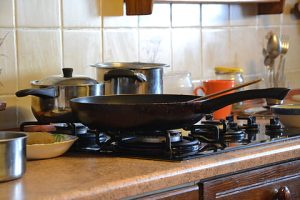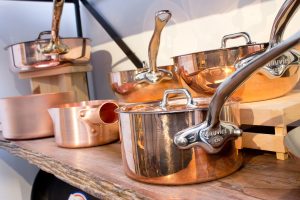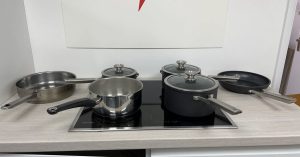I know “how to choose pots and pans set”. It’s not just about the aesthetic appeal but also about how they can impact the quality of the food you cook and your overall experience in the kitchen. The right set can make a world of difference in your culinary pursuits, from frying eggs without sticking to simmering sauces to perfection.
It’s about understanding the different types of materials, their suitability for your cooking style, and the convenience features they offer. This guide aims to help you navigate these choices, to enhance your cooking journey.
How to Choose Pots and Pans Set: To choose pots and pans, consider the material, your cooking style, cost, and additional features like oven safety and handle comfort. Also, assess trusted brands and shopping locations.
Quick Navigation
How to Choose Pots and Pans Set?
When picking out the best pots and pans, you have to think about their shape, size, weight, color, and design. But what they’re made of is even more critical because it affects how your food turns out and how healthy it is.
Most pots and pans are made from metals like cast iron, aluminum, stainless steel, titanium, or ceramics. Ceramic pots and pans are made from clay materials, like porcelain or stoneware, and have a coating made from various chemicals and metals.
Is the Investment in the Always Pan justified?
It costs $125 and comes in seven cool colors. It’s super versatile – you can use it for everything from frying and boiling to braising and steaming. It could replace a bunch of your pots and pans and save some space in your kitchen cabinets.
Our Place has also added to its collection a Perfect Pot and a mini version of the Always Pan. We’ve tried all of them out in the kitchen to see how good they really are.
What kind of Pan is Suitable for use on my Stove?
Many makers put symbols on the bottom of their pots and pans to show which stoves they work with. If you’re not sure, just ask a store worker or check the product’s info online.
Cooking Ranges:
Ask the company that made it. Pots and pans that have a heavy bottom, like the ones made from cast iron, are usually the best choice.
Ceramic Heat:
With a ceramic stove, you can use any pots or pans except those made of copper, stainless steel with a copper bottom showing, or glass. Be sure the pot or pan has a flat, smooth bottom so it touches the stove ring well.
You can use old-fashioned cast iron pans, but be careful. Don’t slide them across the stove because they might scratch it.
Induction Stove:
Induction stoves are getting more popular, but not all pots and pans work with them. If you use the wrong one, it won’t get hot or the stove’s light will start blinking. You need pots and pans with a magnetic bottom, like those made from cast iron or stainless steel.
Pots and pans made only from aluminum or copper will work only if they have a magnetic metal attached to the bottom.
Sealed Heating Plate:
Feel free to use any type of pot or pan you want, just avoid ones made from copper.
Halogen Heat:
For a halogen stove, you can use any pots and pans except for those with copper showing or shiny bottoms. Pick pots and pans with dull or dark bottoms. If they’re too bright, the stove might turn off to stop the glass from getting too hot.
Gas Stove:
You can use any pot or pan on a gas stove. Go for a lighter pan. Pans with thinner bottoms don’t hold onto heat as much as pans with thicker bottoms, which makes it easier to go from boiling to simmering fast.
Make sure the flame isn’t bigger than the bottom of the pan to avoid hurting the handle and wasting gas.
Electric Heat:
You can use any pot or pan with an electric stove, just not the ones made out of copper.
What Factors Should I Consider When Purchasing Pots and Pans?
When choosing pots and pans set, consider dishwasher-safe options and storage solutions. Look for pans with detachable handles for easy stacking.
Avoid hanging pots and pans on a rack as they can gather grease and dust, requiring extra cleaning. Instead, opt for a linear rack with hooks on the wall or install a corner carousel for organized and convenient access.
Copper Cookware:
Copper pans distribute heat evenly but can react with certain foods. High-quality copper pans with tin or stainless steel layers prevent this reaction.
Display copper pans without the layer, use special copper cleaners for maintenance, and opt for sandwich-design copper pans for glass-top stoves and improved heat retention.
Stainless Steel Cookware:
Stainless steel pans last long but can be pricey. They may stick to food, requiring extra oil. Hot spots can be resolved by adding copper or aluminum between two layers of stainless steel.
Safe for dishwashers, stainless steel doesn’t react with food. Heat or minerals can cause rainbow discoloration, removable with stainless steel cleaner.
Cast Iron Cookware:
This pan heats up slowly but retains heat well, ideal for slow cooking or achieving a nice sear. After turning off the heat, the food continues to cook. Cast iron pans, prone to rusting, usually have a non-stick or porcelain enamel coating for protection. Uncoated pans require seasoning with cooking oil.
Hard-Anodized Aluminum Cookware:
Hard-anodized pans have a durable, non-reactive finish. They are easily recognizable by their deep grey or black color. Metal utensils may leave marks, and they are not dishwasher-safe, but food doesn’t stick easily.
These pans are lightweight, heat up quickly without hot spots, and are compatible with most stovetops except for induction hobs. They are a bit expensive but offer excellent performance and longevity.
Aluminum Cookware:
A lot of aluminum pans have a hard shiny coating on the outside and a non-stick layer on the inside. This makes them strong, easy to clean, and they don’t scratch or stain easily. You can also get hard-anodized ones (explained before) or ones made from cast aluminum.
These look like cast iron pans but are lighter and heat up better, thanks to the aluminum. If the pan doesn’t have a coating, you shouldn’t cook acidic foods like tomatoes in it.
Key Considerations
When considering cookware options, there are several key factors to keep in mind:
- Dishwasher-Safe: Pans with plastic or stainless steel handles are usually dishwasher-safe, while those with wooden handles are not.
It’s best to avoid dishwasher use to prolong their lifespan. Most pans only require a quick rinse, soak, or gentle scrub.
- Flat Base: Pans with a flat base efficiently cover the entire hob ring and distribute heat evenly, making them suitable for electric cooking.
- Oven-Safe: Multi-purpose pans can be used both on the hob and in the oven, saving time and storage space. Ensure the handle is oven-proof and check its maximum temperature rating.
- Pouring Lips on Both Sides: Pans with pouring lips on both sides are convenient for households with left- and right-handed chefs.
- Stay-Cool Handles and Knobs: Opt for pans with long, thick handles that remain balanced without being too heavy. Stay-cool technology ensures they are safe to touch during cooking.
FAQs:
Q:1 What should you consider when selecting pots and pans?
When buying pots and pans, prioritize cost, quality, and material. Aesthetics can also be a subjective factor. Ideally, these aspects align when you invest in higher-priced options.
Q:2 Which three pans are essential for your kitchen?
To start your pot collection, you need three essential pots: a two-quart saucepan, a 10-inch sauté pan, and an eight-quart stockpot.
Q:3 What items should be included in a cookware set?
Must-have cookware pieces: 5 essential items
- 10- or 12-inch nonstick skillet: A nonstick skillet serves as the foundation of your kitchen cookware.
- Sauté pan: An important tool for sautéing and stir-frying.
- Small and large saucepans: Necessary for various cooking tasks and sauces.
- Stockpot: Ideal for preparing soups, stocks, and large quantities of food.
- Dutch oven: A versatile pot suitable for braising, slow cooking, and baking.
Conclusion:
In conclusion, choosing the right pots and pans set requires careful consideration of several factors. Start by assessing your cooking needs, such as the type of cooking you do and your preferred cooking appliances.
Consider the cost, quality, and materials of the cookware to ensure durability and performance. Opt for a set that includes essential pieces like a nonstick skillet, sauté pan, saucepans, a stock pot, and a Dutch oven.
Additionally, evaluate the aesthetics and personal preferences to find a set that aligns with your style. By considering these factors, you can make an informed decision and enjoy a well-equipped kitchen for all your culinary adventures.
We hope you will be well aware of how to choose pots and pans set, after reading this comprehensive article. If you have any questions, feel free to comment below!




